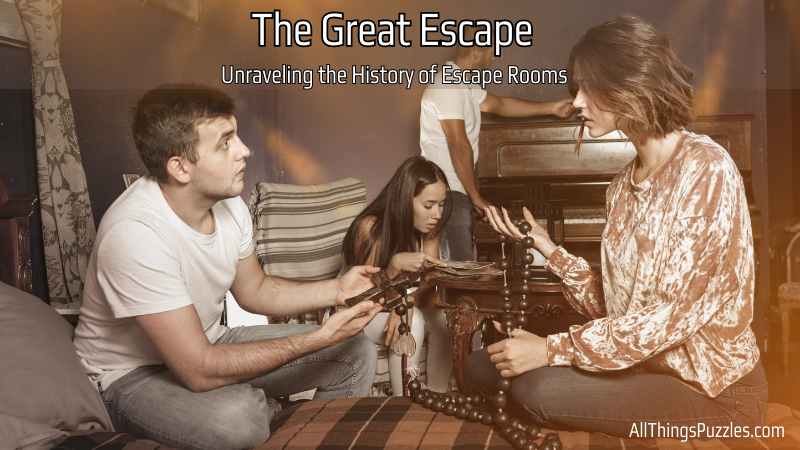Escape rooms have become a global phenomenon, captivating puzzle enthusiasts and adventure seekers alike. But how did they originate, and how have they evolved over time? In this comprehensive guide on All Things Puzzles, we delve into the captivating history of escape rooms, tracing their origins from Japan to their mainstream success worldwide.
Join us as we explore the evolution of escape rooms, from their early beginnings to the immersive experiences they offer today. We’ll discuss their spread to the West, their rise to mainstream success, and the evolution of escape room themes. We’ll also delve into the typical rules of escape rooms, their educational and learning benefits, and the future of escape rooms.
Whether you’re a seasoned escape room enthusiast or a newcomer to this exciting world, this guide is for you. Let’s unravel the history of escape rooms together and discover the thrill of solving puzzles in a group environment.
Where Did Escape Rooms Originate?
Escape rooms first emerged in Japan in the late 2000s, blending elements of video games and interactive theater. The brainchild of SCRAP, the pioneer in this field, their “Real Escape Game” became an instant hit. Unlike traditional escape rooms, the “Real Escape Game” introduced a unique concept that combined elements of puzzle-solving, storytelling, and time pressure.
The success of the “Real Escape Game” can be attributed to its innovative approach and the sense of excitement it brought to participants. It challenged players to work together, unravel mysteries, and escape within a set time limit. The immersive nature of the experience, coupled with the thrill of racing against the clock, captured the attention and imagination of puzzle enthusiasts.
The “Real Escape Game” quickly gained popularity in Japan and paved the way for the global expansion of escape rooms. It demonstrated the immense potential of this interactive form of entertainment, inspiring creators around the world to develop their own unique escape room experiences.
Spread to the West
The concept of escape room games quickly crossed borders, captivating enthusiasts in Asia, Europe, and North America. Budapest and San Francisco became early hubs for escape rooms, drawing in people with a thirst for adventure and problem-solving. With their viral nature, these immersive experiences quickly gained popularity and introduced a wider audience to the thrill of escape rooms.
Mainstream Success

Escape rooms experienced a meteoric rise to mainstream success in the 2010s. Media coverage played a significant role in their widespread appeal, with TV shows and movies showcasing the excitement and suspense of escaping from elaborate puzzles. Corporate team-building activities and special events also embraced escape rooms, recognizing their ability to foster teamwork and collaboration.
Evolution of Escape Room Themes
As the popularity of escape rooms grew, so did the variety of themes and settings. From traditional scenarios like bank heists and prison breaks to more elaborate adventures involving haunted houses, historical mysteries, and sci-fi landscapes, escape room designers pushed the boundaries of imagination. Intricate set designs, technology integration, and captivating storytelling took the escape room experience to new heights.
Typical Rules of Escape Rooms
- Team Size: Escape rooms are designed for groups of players. Most rooms have a recommended team size, usually ranging from 2 to 8 participants. It’s important to adhere to these guidelines to maintain the balance and difficulty level of the puzzles.
- Time Limit: Each escape room has a time limit within which participants must solve all the puzzles and escape. The time limit is typically around 60 minutes, but it can vary. Keep an eye on the clock and manage your time wisely to maximize your chances of success.
- No Physical Force: Escape rooms rely on intellect, observation, and problem-solving rather than physical force. Avoid using excessive strength or damaging any objects within the room. The puzzles are meant to be solved through mental acuity and teamwork.
- Clues and Hints: If you find yourself stuck on a puzzle, don’t worry! Most escape rooms provide clues or hints to assist players. These hints can be obtained through a variety of methods, such as requesting help from a game master or finding hidden clues within the room. Utilize the hints strategically to overcome challenging obstacles.
- Communication and Collaboration: Effective communication and collaboration are key to success in escape rooms. Share information, ideas, and observations with your teammates. Work together to connect clues, solve puzzles, and unlock the next steps. Encourage active participation from everyone in the team.
- Follow Instructions: Pay attention to any specific instructions provided at the beginning of the game. These instructions may include safety guidelines, restrictions on certain objects, or rules specific to the room’s theme. Adhering to these instructions ensures a smooth and enjoyable experience.
Have Fun: Above all, remember that escape rooms are meant to be fun and engaging experiences. Embrace the thrill, enjoy the process of solving puzzles, and immerse yourself in the story and atmosphere of the room. Don’t be afraid to think outside the box and let your creativity shine.
Educational and Learning Benefits

Escape rooms offer more than just entertainment; they also provide valuable educational and learning benefits. Participants develop and hone puzzle-solving skills, learn to work together as a team, improve communication, and sharpen critical thinking abilities. As a result, escape rooms have found their way into educational settings, such as schools and museums, where they offer immersive and engaging learning experiences.
Future of Escape Rooms
The future of escape rooms is filled with endless possibilities. With the rapid advancement of technology, escape rooms are incorporating virtual reality (VR) and augmented reality (AR) to create even more immersive and mind-bending adventures. Imagine exploring fantastical realms or solving puzzles in alternate dimensions—all within the confines of an escape room. Personalized and adaptive experiences are also on the horizon, promising unique challenges tailored to individual preferences and abilities.
FAQs
Are escape rooms suitable for all ages?

Escape rooms cater to a wide range of ages and can be enjoyed by both adults and children. However, it’s essential to check the specific age recommendations provided by each escape room facility. Some rooms may have themes or puzzles that are more suitable for older participants, while others offer family-friendly experiences.
Can I participate in an escape room alone?

While escape rooms are designed to be tackled by a group of people, many facilities offer options for solo players or smaller groups. Some escape rooms may have a minimum number of participants, so it’s advisable to check with the venue beforehand. However, solving puzzles and escaping the room with a team of friends or family can enhance the overall experience.
Are escape rooms scary or claustrophobic?

Escape rooms vary in themes and intensity levels. Some rooms may have elements of suspense or mild scares, such as dim lighting or eerie sounds, to enhance the immersive experience. However, true horror or extreme claustrophobia is generally not a part of escape rooms.
It’s essential to read reviews or descriptions of the room before booking to ensure it aligns with your comfort level. If you have concerns, you can always reach out to the escape room facility and ask about the specific room’s atmosphere.
Additional Reading
Conclusion
From their humble beginnings in Japan to their global popularity today, escape rooms have come a long way. They have captured the hearts and minds of puzzle enthusiasts worldwide, offering thrilling adventures, educational benefits, and unforgettable experiences. Whether you’re a seasoned escape room veteran or new to the world of puzzles, there’s always something new and exciting waiting to be discovered in the ever-evolving world of escape rooms.
With this article, we’ve explored the captivating history of escape rooms, from their origins to their future potential. So gather your team, sharpen your wits, and embark on an unforgettable escape room experience that will test your skills, ignite your imagination, and leave you craving more.
Have you ever participated in an Escape Room? What was your experience? Please comment below.



